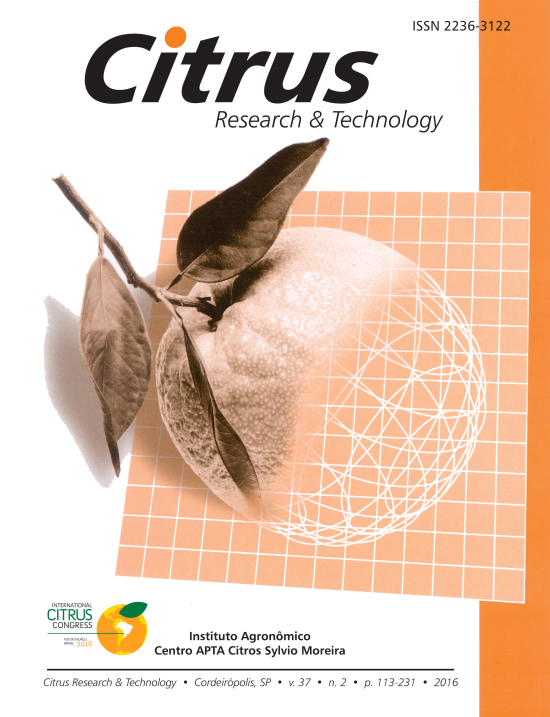QUALIDADE E PRODUÇÃO DE FRUTOS DAS LARANJAS NATAL E VALÊNCIA EM 13 PORTA-ENXERTOS EM BEBEDOURO (SP)1
FRUIT QUALITY AND YIELD OF NATAL AND VALENCIA SWEET ORANGES ON DIFFERENT ROOTSTOCKS IN BEBEDOURO, STATE OF SÃO PAULO, BRAZIL
SIMONE RODRIGUES DA SILVA, DANILO FRANCO, EDUARDO SANCHES STUCHI, LUIZ CARLOS DONADIO, OTAVIO RICARDO SEMPIONATO e DILERMANDO PERECIN
Resumo
Avaliou-se a influência de porta-enxertos na produção e nas características físico-químicas das laranjas Natal e Valência [Citrus sinensis (L.) Osbeck] em dois experimentos, cujo plantio foi realizado em julho de 1993, no espaçamento de 7,0 m entre linhas e 4,0 m entre plantas (357 plantas/ha). O delineamento experimental foi em blocos ao acaso, com 13 e 12 tratamentos, respectivamente, para as variedades-copa Natal e Valência, com três repetições e três plantas por parcela. Os porta-enxertos avaliados foram os seguintes: 10 variedades de tangerinas - Pectinífera, Shekwasha e Pectinífera/Shekwasha (C. depressa Hayata) - Sun Chu Sha Kat, Batangas, Venezuela e Oneco (C. reticulata Blanco); Suen-Kat (C. tangerina hort. ex Tanaka); Nasnaran [C. amblycarpa (Hassk.) Ochse] e Heennaran [C. lycopersicaeformis (Lush.) hort. ex Tan.]; um híbrido de limão Cravo [(C. limonia Osbeck) x tangerina Cleópatra (C. reshni hort. ex Tanaka)]; um citrandarin [C. sunki (Hayata) hort. ex Tanaka x Poncirus trifoliata (L.) Raf. cv. English] e um citrangor [(P. trifoliata x C. sinensis) x C. sinensis]. Este último usado somente para a laranja Natal. Não ocorreram diferenças ignificativas na produção de frutos das laranjas Natal e Valência em função dos porta-enxertos, mas, sim, na qualidade dos frutos cujos valores foram próximos aos padrões das duas variedades, exceto quando enxertadas em Pectinífera e Heennaran, os quais induziram frutos maiores que o usual para Natal e Valência respectivamente.
Palavras-chave
Abstract
It was evaluated the influence of rootstocks on the yield and fruit quality of Valencia and Natal sweet oranges [Citrus sinensis (L.) Osbeck] in two experiments. The experiments were set up in July 1993. The spacing was 7.0 m between rows and 4.0 between trees in a row (357 trees/ha). The experimental design used was randomized blocks, with 13 and 12 treatments, respectively, for the Natal and Valencia sweet oranges, with three replications and three trees per plot. The rootstocks evaluated were 10 varieties of mandarins; Pectinifera, Shekwasha and Pectinifera/Shekwasha (C. depressa Hayata); Sun Chu Sha Kat, Batangas, Venezuela and Oneco (C. reticulata Blanco); Suen-Kat (C. tangerina hort. ex Tanaka); Nasnaran [C. amblycarpa (Hassk.) Ochse]; Heennaran [C. lycopersicaeformis (Lush.) hort. ex Tan.]; a hybrid of Rangpur lime (C. limonia Osbeck) and Cleópatra mandarin (C. reshni hort. ex Tanaka); a citrandarin [C. sunki (Hayata) hort. ex Tan. x P. trifoliata (L.) Raf. cv. English]; and a citrangor [(P. trifoliata x C. sinensis) x C. sinensis]. Thislast one was used only for Natal. Rootstocks did not induce differences in yield. Differences on fruit quality were seen for both cultivars due to different rootstocks but, in general, they were close to the standard values described for them, except for Pectinifera and Heennaran, which induced larger fruits than usual for Natal and Valencia sweet oranges, respectively.

